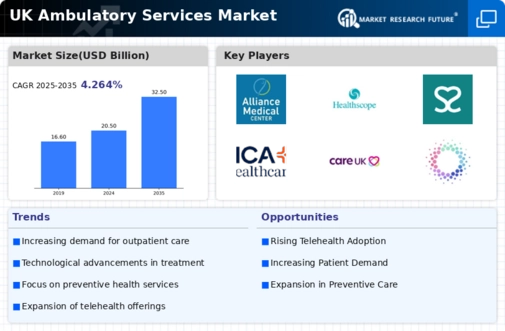Cost-Effectiveness of Ambulatory Care
Cost considerations are playing a pivotal role in the growth of the ambulatory services market. The financial burden associated with inpatient care has prompted both patients and healthcare systems to explore more cost-effective alternatives. Ambulatory care settings typically incur lower operational costs, which can translate to reduced fees for patients. For instance, studies indicate that outpatient procedures can be up to 30% less expensive than their inpatient counterparts. This economic advantage is particularly appealing in the UK, where healthcare budgets are under constant scrutiny. As a result, the ambulatory services market is likely to see continued investment and expansion, as stakeholders recognize the potential for significant savings while maintaining quality care.
Rising Demand for Outpatient Services
The ambulatory services market is experiencing a notable increase in demand for outpatient services, driven by a growing preference for less invasive procedures. Patients are increasingly opting for treatments that allow them to return home the same day, which is reshaping the landscape of healthcare delivery. According to recent data, outpatient visits in the UK have surged by approximately 15% over the past five years. This shift is indicative of a broader trend towards convenience and efficiency in healthcare, as patients seek to minimize hospital stays. The ambulatory services market is thus adapting to meet this demand, with healthcare providers expanding their outpatient offerings to include a wider range of services, from diagnostic tests to minor surgical procedures.
Increased Focus on Patient-Centric Care
The ambulatory services market is witnessing a paradigm shift towards patient-centric care, which emphasizes the importance of tailoring healthcare services to meet individual patient needs. This trend is reflected in the growing emphasis on patient satisfaction and engagement, as healthcare providers seek to create more personalized experiences. In the UK, initiatives aimed at improving patient feedback mechanisms and care pathways are becoming more prevalent. The ambulatory services market is responding by implementing strategies that prioritize patient preferences, ultimately leading to better health outcomes and increased loyalty. This focus on patient-centricity is likely to continue shaping the future of healthcare delivery.
Technological Advancements in Healthcare
Technological innovations are significantly influencing the ambulatory services market, enhancing the efficiency and quality of care provided. The integration of telemedicine, electronic health records, and advanced diagnostic tools is transforming how outpatient services are delivered. For example, telehealth services have expanded access to care, allowing patients to consult with healthcare professionals remotely. This trend is particularly relevant in the UK, where the adoption of digital health solutions has increased by over 40% in recent years. Such advancements not only improve patient outcomes but also streamline operations within the ambulatory services market, making it more responsive to patient needs and preferences.
Aging Population and Chronic Disease Management
The demographic shift towards an aging population in the UK is exerting considerable pressure on the healthcare system, thereby driving the growth of the ambulatory services market. Older adults typically require more frequent medical attention, particularly for chronic conditions such as diabetes and hypertension. The ambulatory services market is increasingly focusing on chronic disease management programs that cater to this demographic, offering regular monitoring and treatment options that can be administered in outpatient settings. This approach not only enhances patient quality of life but also alleviates the burden on inpatient facilities, allowing for more efficient use of healthcare resources.






















Leave a Comment